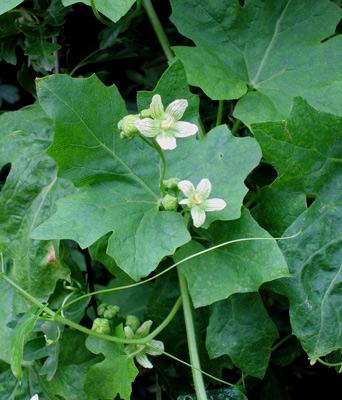Contents:
Common Names | Parts Usually Used | Plant(s) & Culture | Where Found | Medicinal Properties
Legends, Myths and Stories | Uses | Formulas or Dosages | Warning | Bibliography
Scientific Names

- Bryonia alba L.
- Gourd family
Common Names
- Kua-lou
- Ladies’ seal
- Tamus
- Tetterberry
- White bryony
- Wild bryony
- Wild hops
- Wild vine
- Wood vine
Parts Usually Used
Rootstock
Back to Top
Description of Plant(s) and Culture
White bryony is a perennial climbing plant; the prickly stem grows to a length of 10 feet and climbs using spiral tendrils that grow opposite to the leaves. The rootstock is dirty white, spindle-shaped and fleshy and contains milky juice. The leaves are cordate, five-lobed, and rough. Small, greenish-white or yellowish flowers grow in axillary corymbs from June or August. The fruit is a black, pea-sized berry.
Another variety: Red bryony
Back to Top
Where Found
Cultivated in the United States and Europe, and occasionally found wild in moist areas and vineyards of Europe.
Back to Top
Medicinal Properties
Pectoral, purgative, anti-rheumatic
Back to Top
Legends, Myths and Stories
Bryony was considered a wicked plant in the Middle Ages. Medieval con men passed off carved bryony roots as mandrakes, making great profits and deceiving many people, including childless women who bought the root as a fertility drug or charm.
Back to Top
Uses
White bryony is a powerful purgative. In Germany, the rootstock is hollowed out and filled with beer. After
Back to Top
Formulas or Dosages
Except in an emergency, do not use white bryony without medical supervision.
Infusion: use
Tincture: a dose is
Back to Top
Warning
White byrony purges violently; should have medical supervision.
The rootstock is poisonous in large doses. The berries are very poisonous.
Another variety: Red bryony
Do not use either Red or White Byrony without medical supervision.
Back to Top
Bibliography
![]() The Complete Medicinal Herbal
The Complete Medicinal Herbal, by Penelope Ody, Dorling Kindersley, Inc, 232 Madison Avenue, New York, NY 10016, First American Edition, copyright 1993
![]() Culpeper’s Complete Herbal & English Physician: Updated With 117 Modern Herbs
Culpeper’s Complete Herbal & English Physician: Updated With 117 Modern Herbs, by Nicholas Culpeper, Meyerbooks, publisher, PO Box 427, Glenwood, Illinois 60425, 1990, (reprint of 1814)
![]() The Herb Book
The Herb Book, by John Lust, Bantam Books, 666 Fifth Avenue, New York, NY. copyright 1974.
![]() Chinese Medicinal Herbs
Chinese Medicinal Herbs, compiled by Shih-Chen Li, Georgetown Press, San Francisco, California, 1973.
![]() The Nature Doctor: A Manual of Traditional and Complementary Medicine
The Nature Doctor: A Manual of Traditional and Complementary Medicine, by Dr. H.C.A. Vogel; Keats Publishing, Inc., 27 Pine Street (Box 876) New Canaan, CT. 06840-0876. Copyright Verlag A. Vogel, Teufen (AR) Switzerland 1952, 1991
![]() Planetary Herbology
Planetary Herbology, by Michael Tierra, C.A., N.D., O.M.D., Lotus Press, PO Box 325, Twin Lakes. WI 53181., Copyright 1988, published 1992
![]() Webster’s New World Dictionary
Webster’s New World Dictionary, Third College Edition, Victoria Neufeldt, Editor in Chief, New World Dictionaries: A Division of Simon & Schuster, Inc., 15 Columbus Circle, New York, NY 10023
